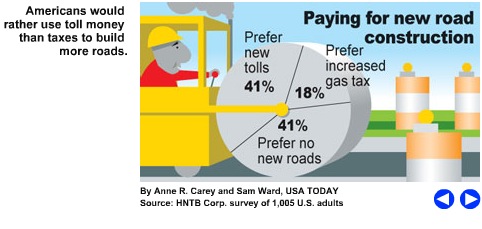USA Today had a timely graphic up yesterday, considering the continuing media coverage around President Obama’s recent proposal for infrastructure spending and a reformed long-term transportation bill.
First, the graphic:

Though we can’t see the rest of the questions or the context, it affirms a few things we already know about Americans’ attitudes about transportation — as evidenced in our own 2010 national poll — and how to fund what we need.
While Americans are actually voting in favor of taxing themselves to improve transportation in state and local ballot measures at a rate of about 70 percent, they often know exactly what they’re going to get in those cases: a new bridge, an expanded transit system, a system of repaired roads, or the like. But the federal program is much fuzzier in most people’s minds. The current system is broken and unaccountable, and putting more money into a broken system is like trying to bring more water up from a well using a bucket with a hole in it.
As James Corless wrote in an Infrastructurist guest post yesterday, “Some of the old guard transportation insiders in D.C. would be thrilled with doubling the overall size of our transportation program and pouring more money into the same broken system, but Americans know better. They want more accountability, safer streets, and more transportation options so seniors can maintain their independence and low wage workers can get to jobs.”
It’s also interesting that the sentence to the left of the poll summarizes it as “Americans would rather use tolls than taxes to build more roads,” when it could have just as easily been “Americans are OK with building no new roads if it means raising the gas tax or instituting tolls to pay for them.”
Maybe the poll asks the wrong question?
We’re not in favor of a moratorium on any new roads whatsoever, but this survey clearly reinforces the fact that Americans in urban and rural areas have moved beyond the idea that the solution to every transportation problem can and should be a new road.
We cooperated on a poll in 2009 with the National Association of Realtors, showing that Americans don’t think expanding roads and highways are the best use of scarce transportation dollars:
“As the federal government makes its plans for transportation funding in 2009, which ONE of the following should be the top priority?”
| Maintaining and repairing roads, highways, freeways and bridges |
Expanding and improving bus, rail, and other public transportation |
Expanding and improving roads, highways, freeways and bridges |
Not sure |
| 50% |
31% |
16% |
3% |
And as our 2010 poll showed, more than four-in-five voters (82 percent) say that “the United States would benefit from an expanded and improved transportation system, such as rail and buses” and a solid majority (56 percent) “strongly agree” with that statement. Fully 79 percent of rural voters agree as well, despite much lower use of public transportation compared to Americans in urban areas.
If you saw this graphic and your curiosity was piqued, perhaps it’s worth going back and poking through our national poll for a fuller picture.







